Mobile communication in the global south
电子专业英语lesson26-GSM
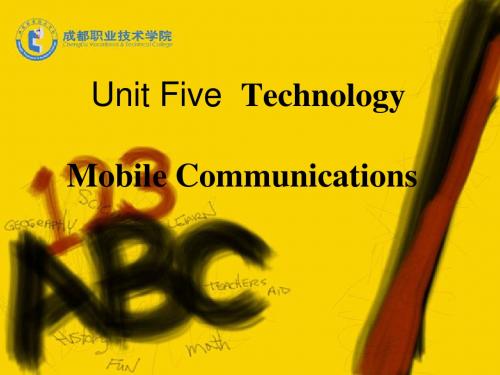
GPRS General Packet Radio Service 通用无线分组业务
['iminənt] 逼近的,即将发生的
• The imminent arrival of 3G services is challenging operators to provide consumer access to high-speed, multimedia data service and seamless integration with the Internet. • For operators now offering 2G services, GSM provides a clear way to make the most of this transition to 3G.
ISDN 综合业务数据网
特别移动小组
• GSM initially stood for Group Special Mobile. • The CEPT formed the group to develop a PanEuropean cellular system to replace the many systems already in place in Europe that were all incompatible.
Unit Five Technology Mobile Communications
['seljulə] 蜂窝的,细胞的
• GSM is one of the leading mobile networks in the world with over 60% of the world cellular market. • The development of GSM started in the early 1980s. • It was the mainstay of the plans for Europe’s mobile communication infrastructure for the ['infrə'strʌktʃə] 1990s. 基础结构,基础设施
现代移动通信 毕业论文外文翻译 (2)

一、英文原文Modern mobile communication technologyIn now highly the information society, the information and the correspondence have become the modern society “the life”. The information exchange mainly relies on the computer correspondence, but corresponds takes the transmission method, with the sensing technology, the computer technology fuses mutually, has become in the 21st century the international society and the world economic development powerful engine. In order to of adapt the time request, the new generation of mobile communication technology seasonable and lives, the new generation of mobile communication technology is the people said that third generation's core characteristic is the wide band addressing turns on non-gap roaming between the rigid network and numerous different communications system's, gains the multimedia communication services.Along with the time progress, the technical innovation, people's life request's enhancement, the mobile communication technology renewal speed is quite astonishing, almost every other ten year mobile communication technology has a transformation update, from the 1980s “the mobile phone” to present's 3G handset, during has had two mobile communication technology transformation, transits from 1G AMPS to 2G GSM, from GSM to IMT-2000 (i.e. 3G technology). Knows modern on me the mobile communication technology to have the following several aspect important technology:1. wideband modulation and multiple access techniqueThe wireless high speed data transmission cannot only depend on the frequency spectrum constantly the expansion, should be higher than the present number magnitude at least in the frequency spectrum efficiency, may use three technologies in the physical level, namely OFDM, UWB and free time modulation code. OFDM with other encoding method's union, nimbly OFDM and TDMA, FDMA, CDMA, SDMA combines the multiple access technique.In the 1960s the OFDM multi-channel data transmission has succeeded uses in complex and the Kathryn high frequency military channels. OFDM has used in 1.6 M bit/s high bit rate digital subscriber line (HDSL), 6 M bit/s asymmetrical digital subscriber line (ADSL), 100 M bit/s really high speed figure subscriber's line (VDSL), digital audio frequency broadcast and digital video broadcast and so on. OFDM applies on 5 GHz provides 54 M bit/s wireless local network IEEE 802.11 a and IEEE 802.11g, high performance this region network Hi per LAN/2 and ETSI-BRAN, but also takes metropolitan area network IEEE 802.16 and the integrated service digit broadcast (ISDB-T) the standard. Compares with the single load frequency modulation system service pattern, the OFDM modulation service pattern needs to solve the relatively big peak even power ratio (PAPR, Peak to Average Power Ratio) and to the frequency shifting and the phase noise sensitive question.High speed mobile communication's another request is under the wide noise bandwidth, must demodulate the signal-to-noise ratio to reduce as far as possible, thus increases the cover area. May adopt the anti-fading the full start power control and the pilot frequency auxiliary fast track demodulation technology, like the frequency range anti-fading's Rake receive and the track technology, the OFDMA technology which declines from the time domain and the frequencyrange resistance time and the frequency selectivity, the link auto-adapted technology, the union coding technique.2. frequency spectrum use factor lift techniqueThe fundamental research pointed out: In the independent Rayleigh scattering channel, the data rate and the antenna several tenth linear relationships, the capacity may reach Shannon 90%. Is launching and the receiving end may obtain the capacity and the frequency spectrum efficiency gain by the multi-antenna development channel space. The MIMO technology mainly includes the spatial multiplying and the space diversity technology, concurrent or the salvo same information enhances the transmission reliability on the independent channel.Receives and dispatches the bilateral space diversity is the high-capacity wireless communication system uses one of technical. Bell Lab free time's opposite angle BLAST (D-BLAST) capacity increase to receive and dispatch the bilateral smallest antenna number in administrative levels the function. The cross time domain which and the air zone expansion signal constitutes using MIMO may also resist the multi-diameter disturbance. V-BLAST system when indoor 24~34 dB, the frequency spectrum use factor is 20~40 bit/s/Hz. But launches and the receiving end uses 16 antennas, when 30 dB, the frequency spectrum use factor increases to 60~70 bit/s/Hz.The smart antenna automatic tracking needs the signal and the auto-adapted free time processing algorithm, produces the dimensional orientation wave beam using the antenna array, causes the main wave beam alignment subscriber signal direction of arrival through the digital signal processing technology, the side lobe or zero falls the alignment unwanted signal direction of arrival. The auto-adapted array antennas (AAA, Adaptive Array Antennas) disturbs the counter-balance balancer (ICE, Interference Canceling Equalizer) to be possible to reduce disturbs and cuts the emissive power.3. software radio technologyThe software radio technology is in the hardware platform through the software edition by a terminal implementation different system in many kinds of communication services. It uses the digital signal processing language description telecommunication part, downloads the digital signal processing hardware by the software routine (DSPH, Digital Signal Processing Hardware). By has the general opening wireless structure (OWA, Open Wireless Architecture), compatible many kinds of patterns between many kinds of technical standards seamless cut.UWB is also called the pulse to be radio, the modulation uses the pulse width in the nanosecond level fast rise and the drop pulse, the pulse cover frequency spectrum from the current to the lucky hertz, does not need in the radio frequency which the convention narrow band frequency modulation needs to transform, after pulse formation, may deliver directly to the antenna launch.4. software radio technologyThe software radio technology is in the hardware platform through the software edition by a terminal implementation different system in many kinds of communication services. It uses the digital signal processing language description telecommunication part, downloads the digital signal processing hardware by the software routine (DSPH, Digital Signal Processing Hardware). By has the general opening wireless structure (OWA, Open Wireless Architecture), compatible many kinds of patterns between many kinds of technical standards seamless cut.5. network security and QoSQoS divides into wireless and the wired side two parts, wireless side's QoS involves theradio resource management and the dispatch, the admission control and the mobility management and so on, the mobility management mainly includes the terminal mobility, individual mobility and service mobility. Wired side's QoS involves based on the IP differ discrimination service and the RSVP end-to-end resources reservation mechanism. Mechanism maps the wireless side IP differ IP the QoS. Network security including network turning on security, core network security, application security, safety mechanism visibility and configurable.In the above modern mobile communication key technologies' foundation, has had the land honeycomb mobile communication, the satellite communication as well as the wireless Internet communication, these mailing address caused the correspondence appearance to have the huge change, used the digital technique the modern wireless communication already to permeate the national economy each domain and people's daily life, for this reason, we needed to care that its trend of development, hoped it developed toward more and more convenient people's life's direction, will let now us have a look at the modern mobile communication the future trend of development.modern mobile communication technological development seven new tendencies :First, mobility management already from terminal management to individual management and intelligent management developmentSecond, network already from synchronized digital circuit to asynchronous digital grouping and asynchronous transfer mode (ATM) development;the three, software's developments actuated from the algorithm to the procedure-oriented and face the goal tendency development;the four, information processing have developed from the voice to the data and the image;five, wireless frequency spectrum processing already from narrow band simulation to the narrow band CDMA development;the six, computers have developed from central processing to the distributional server and intellectualized processing;the seven, semiconductor devices have developed from each chip 16,000,000,000,000 /150MHz speed VLSI to 0.5 /350MHz speed VLSI and 2,000,000,000,000,000 /550MHz speed VLSI.Under this tendency's guidance, the mobile service rapid development, it satisfied the people in any time, any place to carry on the correspondence with any individual the desire. The mobile communication realizes in the future the ideal person-to-person communication service way that must be taken. In the information support technology, the market competition and under the demand combined action, the mobile communication technology's development is progresses by leaps and bounds, presents the following several general trends: work service digitization, grouping; 2. networking wide band; working intellectualization; 4.higher frequency band; 5. more effective use frequency; 6.each kind of network tends the fusion. The understanding, grasps these tendencies has the vital practical significance to the mobile communication operator and the equipment manufacturer.二、英文翻译现代移动通信在当今高度信息化的社会,信息和通信已成为现代社会的“命脉”。
移动通信英文作文

移动通信英文作文英文:As a user of mobile communication, I think it has brought great convenience to people's lives. With the development of technology, mobile phones have become more and more intelligent, not only can make calls and send messages, but also can surf the Internet, take photos, play games and so on. It's like having a mini computer in our pocket.However, the excessive use of mobile phones has also brought some negative effects. For example, some people are addicted to mobile phones and cannot get rid of them, which affects their work and study. In addition, the radiation from mobile phones may also pose a potential health hazard to users.In my opinion, we should make reasonable use of mobile phones and avoid excessive use. We can set a time limit forusing mobile phones every day, and try to put down our phones when we are with our families or friends, so as to better communicate with them. As for the potential health hazards, we can choose mobile phones with lower radiation levels or use headphones when making phone calls.中文:作为移动通信的用户,我认为它给人们的生活带来了很大的便利。
移动电话的使用越来越普及英语作文
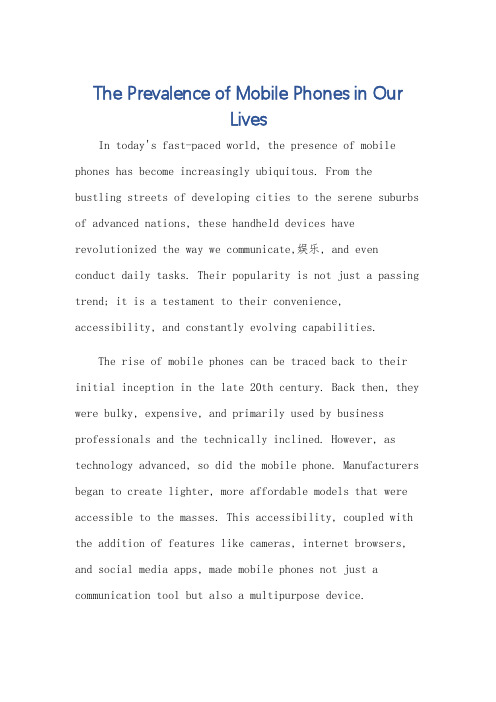
The Prevalence of Mobile Phones in OurLivesIn today's fast-paced world, the presence of mobile phones has become increasingly ubiquitous. From thebustling streets of developing cities to the serene suburbs of advanced nations, these handheld devices have revolutionized the way we communicate,娱乐, and even conduct daily tasks. Their popularity is not just a passing trend; it is a testament to their convenience, accessibility, and constantly evolving capabilities.The rise of mobile phones can be traced back to their initial inception in the late 20th century. Back then, they were bulky, expensive, and primarily used by business professionals and the technically inclined. However, as technology advanced, so did the mobile phone. Manufacturers began to create lighter, more affordable models that were accessible to the masses. This accessibility, coupled with the addition of features like cameras, internet browsers, and social media apps, made mobile phones not just a communication tool but also a multipurpose device.Today, mobile phones have become an integral part of our daily lives. We use them to stay connected with friends and family, to access information quickly, and even to conduct financial transactions. Their portability allows us to take them anywhere, making them a constant companion in our daily adventures. Furthermore, with the advent of smartphones, we can now perform tasks that were once considered impossible on such a small device. From editing videos and photos to playing games and watching movies, smartphones have truly transformed the way we live.Despite their numerous benefits, however, the prevalence of mobile phones has also given rise to some concerns. One such concern is the potential for addiction, as people find themselves constantly checking their phones for updates or notifications. This constant engagement can lead to decreased social interaction and a lack of focus on other important tasks. Additionally, the excessive use of mobile phones can also strain the eyes and lead to other health issues.To mitigate these concerns, it is important to strike a balance between mobile phone use and other activities. Weshould make an effort to engage in face-to-face interactions, take breaks from our screens, and prioritize other aspects of our lives. By doing so, we can ensure that while mobile phones remain a valuable tool in our lives, they do not overshadow the important things that matter most.In conclusion, the prevalence of mobile phones in our lives is a testament to their value and utility. They have revolutionized the way we communicate,娱乐, and conductdaily tasks, making our lives more convenient and efficient. However, it is crucial that we use them responsibly, avoiding addiction and ensuring that they do not overshadow the important things in life. By doing so, we can continueto enjoy the benefits of mobile phones while maintaining a healthy and balanced lifestyle.**移动电话的普及与我们的生活**在当今快节奏的社会中,移动电话的普及已经变得无处不在。
手机的出现对于人们沟通的影响英语作文
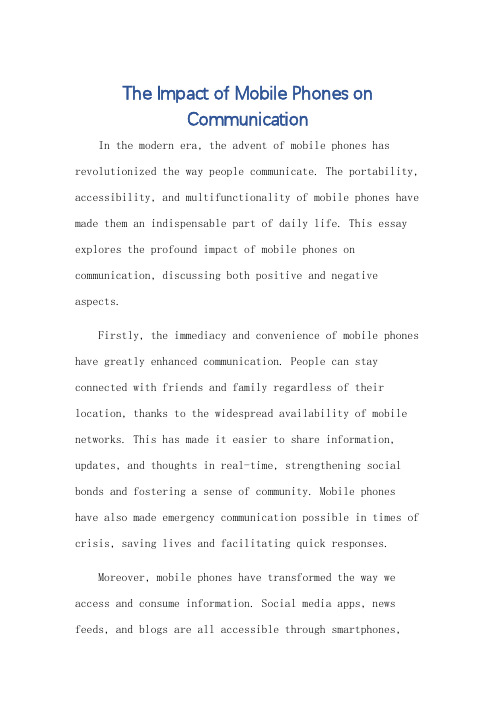
The Impact of Mobile Phones onCommunicationIn the modern era, the advent of mobile phones has revolutionized the way people communicate. The portability, accessibility, and multifunctionality of mobile phones have made them an indispensable part of daily life. This essay explores the profound impact of mobile phones on communication, discussing both positive and negative aspects.Firstly, the immediacy and convenience of mobile phones have greatly enhanced communication. People can stay connected with friends and family regardless of their location, thanks to the widespread availability of mobile networks. This has made it easier to share information, updates, and thoughts in real-time, strengthening social bonds and fostering a sense of community. Mobile phones have also made emergency communication possible in times of crisis, saving lives and facilitating quick responses.Moreover, mobile phones have transformed the way we access and consume information. Social media apps, news feeds, and blogs are all accessible through smartphones,enabling users to stay updated with the latest news and trends. This has democratized information access, giving voice to people from all backgrounds and perspectives. Mobile phones have also fostered new forms of expression and creativity, such as blogging, video blogging, andsocial media posts, which have enabled individuals to share their stories and perspectives with a wider audience.However, the rise of mobile phones has also presented some challenges to communication. One significant concern is the rise of distracted communication. With people constantly checking their phones for updates and notifications, it has become increasingly difficult to maintain focused and meaningful conversations. This has led to a decrease in the quality and depth of communication, with people often opting for brief and superficial exchanges over longer and more substantial ones.Furthermore, the overuse of mobile phones can lead to addiction and dependency, affecting individuals' mental health and well-being. Constant checking of social media and notifications can lead to feelings of anxiety, loneliness, and dissatisfaction. This has led to a rise incyberbullying, cyber-stalking, and other forms of digital abuse, which can have serious consequences for victims.Moreover, the widespread use of mobile phones has raised privacy concerns. With so much personal information stored on phones, there is an increased risk of data breaches and misuse. Hackers and other maliciousindividuals can exploit this information for fraudulent activities or other malicious purposes, putting users' security and privacy at risk.In conclusion, while mobile phones have revolutionized communication and brought numerous benefits, they have also presented some challenges. The immediacy and convenience of mobile phones have greatly enhanced communication, but they have also led to distracted communication and addiction. Privacy concerns and the rise of digital abuse are other important issues that need to be addressed. It is crucial to strike a balance between utilizing the benefits of mobile phones while also being mindful of their potential downsides. By doing so, we can ensure that mobile phones continue to enhance our communication and socialconnections while also protecting our privacy and mental health.**手机出现对于人们沟通的影响**在现代社会,手机的出现彻底改变了人们的沟通方式。
MOBILE COMMUNICATIONS
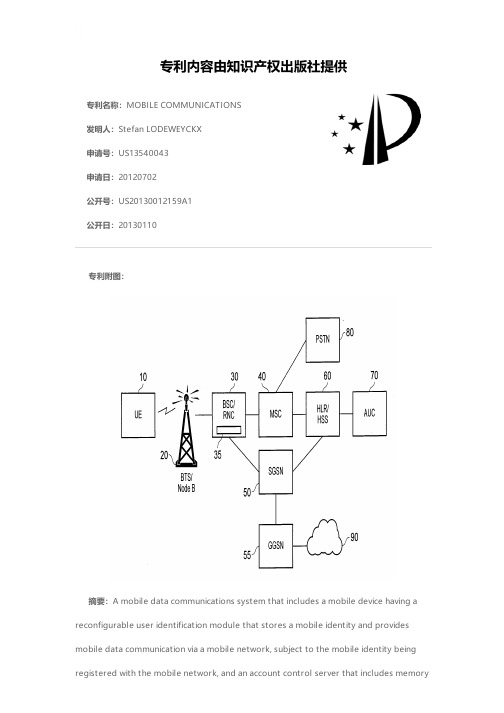
专利名称:MOBILE COMMUNICATIONS发明人:Stefan LODEWEYCKX申请号:US13540043申请日:20120702公开号:US20130012159A1公开日:20130110专利内容由知识产权出版社提供专利附图:摘要:A mobile data communications system that includes a mobile device having a reconfigurable user identification module that stores a mobile identity and provides mobile data communication via a mobile network, subject to the mobile identity being registered with the mobile network, and an account control server that includes memoryto store identification and payment details for a user of the mobile device and a mobile identity provider to provide a mobile identity to the mobile device and to an authorization server of a mobile network. In response to a request by a user of the mobile device to obtain data access by a particular mobile network, the account control server provides a mobile identity to the mobile device for storage by the user identification module, provides the same mobile identity to the authorization server of that mobile network, and provides user identification and payment details to that mobile network.申请人:Stefan LODEWEYCKX地址:Herent BE国籍:BE更多信息请下载全文后查看。
手机网络传输方式
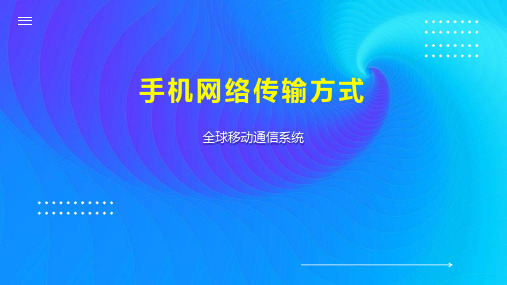
CDMA手机与GSM手机相比:CDMA手机具有以下优点:CDMA手机采用了先进的切换技术:软切换技 术 (即切换是先接续好后再中断),使得CDMA手机的通话可以与固定媲美;使用CDMA络,运营商 的投资相对减少,这就为CDMA手机资费的下调预留了空间;因采用以拓频通信为基础的一种调制 和多址通信方式,其容量比模拟技术高10倍,超过GSM络约4倍;基于宽带技术的CDMA使得移动 通信中视频应用成为可能,从而使手机从只能打和发送短信息等狭窄的服务中走向宽带多媒体应 用。
由于GSM发展极快,在其900MHZ频段满以后,又开辟了GSM1800频段,手机工作在900MHZ和 1800MHZ频段以及GSM1900MHz等几个频段。
GPRS
GPRS:GPRS是General Packet Radio Service的英文简称,中文为通用无线分组业务,是一种 基于 GSM系统的无线分组交换技术,提供端到端的、广域的无线IP连接。相对原来GSM的拨号方 式的电路交换数据传送方式,GPRS是分组交换技术,具有“实时在线”、“按量计费”、“快捷 登录”、 “高速传输”、“自如切换”的优点。通俗地讲,GPRS是一项高速数据处理的技术, 方法是以“分组”的形式传送资料到用户手上。虽然GPRS是作为现有GSM络向第三代移动通信过 渡的过渡技术,但是它在许多方面都具有显著的优势。
在中国,从1994年底开始,十多个省市如火如荼地筹建手机络传输方式蜂窝移动通信。这个伟大 的工程,其发展势头之猛,让人惊叹。到现在,手机络传输方式数字已经覆盖全国30多个省(区、 市),300多个地区和2000多个县市。这些地方,如同星星之火,已经燎原。
更为惊人的是,这些络不仅可以覆盖国内所有地区,还可以与40多个国家实现漫游。
通俗地讲,GPRS是一项高速数据处理的技术,方法是以“分组”的形式传送资料到用户手上。虽 然GPRS是作为现有手机络传输方式络向第三代移动通信过渡的过渡技术,但是它在许多方面都具 有显著的优势。
2-3 Mobile Communication
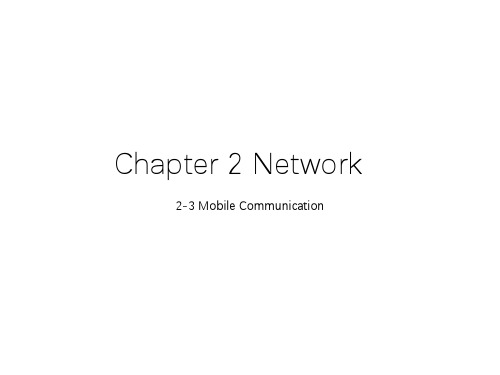
Exercises
Choices:
1. The mobile communications has experienced
A. one
B. two
C. three
D. four
stages.
2.
is the newest technology.
A. 2G
B. 3G
C.4G
D. 2.5G
3. The information both voice and
A. data
B. e-mail
C. image
D. Video
can be transmitted by 3G
Exercises
4. is the short name of the first generation mobile communication.
A. 1G
B.2G
C.3G
D. 4G
Key words: information [ˌɪnfəˈmeɪʃn] n.信息
2-3 Mobile Communication
3G is the third generation mobile
communication
technology.
The
information both voice and data can be
Байду номын сангаас
1G表示第一代移动通信技术。 1G无线系统在设计上只能传 输语音流量,并受到网络容 量的限制。
Key words: generation [ˌdʒenəˈreɪʃn] n.一代;代 voice [vɔɪs] n.声音、语音 traffic [ˈtræfɪk] n.流量,交通 transmit [trænsˈmɪt] vt.传送,传播,传输
对移动通信专业课的英文作文
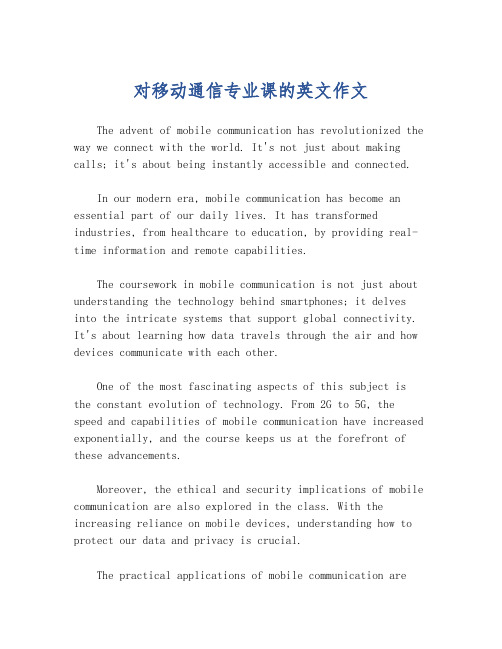
对移动通信专业课的英文作文The advent of mobile communication has revolutionized the way we connect with the world. It's not just about making calls; it's about being instantly accessible and connected.In our modern era, mobile communication has become an essential part of our daily lives. It has transformed industries, from healthcare to education, by providing real-time information and remote capabilities.The coursework in mobile communication is not just about understanding the technology behind smartphones; it delves into the intricate systems that support global connectivity. It's about learning how data travels through the air and how devices communicate with each other.One of the most fascinating aspects of this subject is the constant evolution of technology. From 2G to 5G, the speed and capabilities of mobile communication have increased exponentially, and the course keeps us at the forefront of these advancements.Moreover, the ethical and security implications of mobile communication are also explored in the class. With the increasing reliance on mobile devices, understanding how to protect our data and privacy is crucial.The practical applications of mobile communication arevast. From developing apps that can save lives in emergency situations to creating systems that can monitor and manage traffic flow, the possibilities are endless.In conclusion, the mobile communication course is a comprehensive journey through the world of wireless technology. It's not just about the past and present; it's about preparing us for the future and the role we will play in shaping it.。
移动通信奖学金英语作文
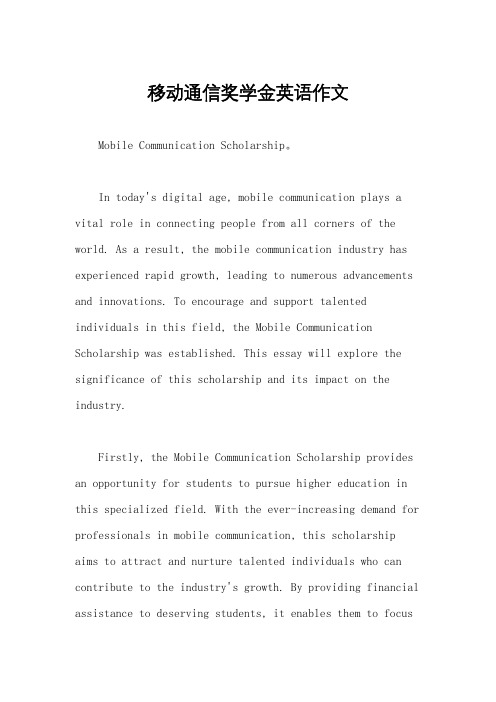
移动通信奖学金英语作文Mobile Communication Scholarship。
In today's digital age, mobile communication plays a vital role in connecting people from all corners of the world. As a result, the mobile communication industry has experienced rapid growth, leading to numerous advancements and innovations. To encourage and support talented individuals in this field, the Mobile Communication Scholarship was established. This essay will explore the significance of this scholarship and its impact on the industry.Firstly, the Mobile Communication Scholarship provides an opportunity for students to pursue higher education in this specialized field. With the ever-increasing demand for professionals in mobile communication, this scholarship aims to attract and nurture talented individuals who can contribute to the industry's growth. By providing financial assistance to deserving students, it enables them to focuson their studies and develop their skills in mobile communication technology.Moreover, the Mobile Communication Scholarship serves as a platform for fostering innovation and research in the field. Recipients of the scholarship are encouraged to undertake research projects that push the boundaries of mobile communication technology. This not only benefits the scholarship recipients but also contributes to the overall advancement of the industry. The scholarship acts as a catalyst for groundbreaking discoveries and inventions that can revolutionize the way we communicate.Furthermore, the Mobile Communication Scholarship promotes diversity and inclusivity within the industry. It recognizes the importance of different perspectives and backgrounds in driving innovation. By offeringopportunities to students from various socio-economic backgrounds, the scholarship ensures that the mobile communication industry is not limited to a select few. This inclusivity fosters creativity and encourages fresh ideas, ultimately leading to a more dynamic and progressiveindustry.Additionally, the Mobile Communication Scholarshipplays a crucial role in bridging the gap between academia and industry. Many scholarship programs include internships or job placements in leading mobile communication companies. This allows students to gain practical experience and apply their theoretical knowledge in real-world scenarios. By fostering collaboration between academia and industry, the scholarship facilitates the transfer of knowledge and promotes the development of industry-ready professionals.Moreover, the Mobile Communication Scholarship contributes to the overall growth and competitiveness ofthe mobile communication industry. By investing in the education and development of talented individuals, the scholarship ensures a steady supply of skilled professionals. This, in turn, drives innovation, enhances the quality of products and services, and strengthens the industry's global position. The scholarship acts as a catalyst for growth, enabling the industry to keep pacewith the ever-evolving demands of the digital era.In conclusion, the Mobile Communication Scholarship plays a vital role in supporting students in pursuing higher education in mobile communication. It fosters innovation, promotes inclusivity, bridges the gap between academia and industry, and contributes to the overall growth of the industry. As the world becomes increasingly connected, the importance of mobile communication cannot be overstated. The Mobile Communication Scholarship serves as a beacon of hope, nurturing the next generation of professionals who will shape the future of this industry.。
通讯文英语作文800字
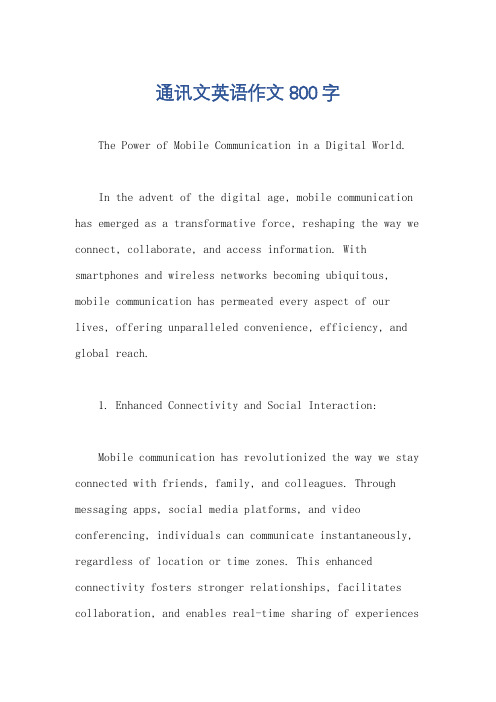
通讯文英语作文800字The Power of Mobile Communication in a Digital World.In the advent of the digital age, mobile communication has emerged as a transformative force, reshaping the way we connect, collaborate, and access information. With smartphones and wireless networks becoming ubiquitous, mobile communication has permeated every aspect of our lives, offering unparalleled convenience, efficiency, and global reach.1. Enhanced Connectivity and Social Interaction:Mobile communication has revolutionized the way we stay connected with friends, family, and colleagues. Through messaging apps, social media platforms, and video conferencing, individuals can communicate instantaneously, regardless of location or time zones. This enhanced connectivity fosters stronger relationships, facilitates collaboration, and enables real-time sharing of experiencesand emotions.2. Access to Information and Knowledge:Mobile devices provide instant access to a vast repository of information through the internet. Search engines, news feeds, and educational apps empowerindividuals to acquire knowledge, stay informed, and make informed decisions. This democratization of information has empowered marginalized communities, bridged knowledge gaps, and accelerated personal growth.3. Improved Business Efficiency and Productivity:Mobile communication has become an indispensable toolfor businesses of all sizes. Email, mobile applications,and cloud-based platforms enable employees to work remotely, collaborate seamlessly, and respond quickly to customer inquiries. This increased flexibility and responsiveness enhances productivity, reduces costs, and improves overall operational efficiency.4. Empowerment of Remote and Underserved Communities:Mobile communication has played a crucial role in bridging the digital divide and empowering remote and underserved communities. By providing access to technology and connectivity, individuals in marginalized areas can engage in education, healthcare, and economic opportunities that were previously inaccessible. This inclusive approach promotes social equity and fosters sustainable development.5. Emergency Response and Disaster Relief:During emergencies and natural disasters, mobile communication becomes a lifeline. Real-time alerts,location tracking, and emergency broadcasts help communities respond quickly and effectively. Mobile devices also serve as essential tools for first responders, enabling them to coordinate efforts, locate victims, and provide critical aid.6. Advancement of Healthcare:Mobile communication has revolutionized healthcare delivery. Telemedicine apps allow patients to consult with healthcare professionals remotely, reducing wait times and improving access to specialized care. Mobile health devices, such as fitness trackers and diagnostic tools, empower individuals to monitor their health and make informed decisions about their well-being.7. Global Reach and Cultural Exchange:Mobile communication transcends geographical boundaries, fostering global connections and cultural exchange. Social media platforms and messaging apps enable individuals to share their experiences, perspectives, and ideas withpeople from diverse backgrounds. This interconnectedness promotes understanding, tolerance, and the appreciation of different cultures.8. Innovation and Technological Advancements:The rapid evolution of mobile communication has spurred innovation and technological advancements. The developmentof 5G networks, artificial intelligence, and wearable devices promises even greater connectivity, enhanced functionality, and transformative applications. These advancements will continue to shape the future of communication and its impact on our lives.Conclusion:Mobile communication has profoundly transformed the way we live, work, and connect with the world. Its vast reach, convenience, and ability to bridge gaps and empower marginalized communities make it an indispensable tool in the digital age. As mobile technology continues to evolve, we can anticipate even greater advancements and transformative applications that will further shape our future.。
通信技术的发达英语作文
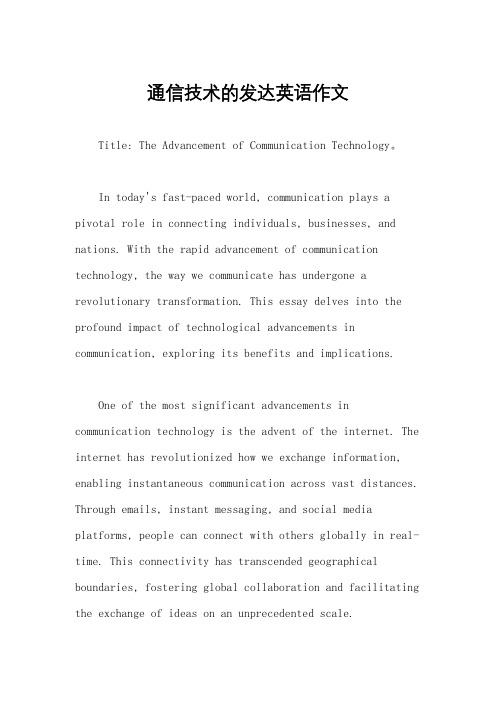
通信技术的发达英语作文Title: The Advancement of Communication Technology。
In today's fast-paced world, communication plays a pivotal role in connecting individuals, businesses, and nations. With the rapid advancement of communication technology, the way we communicate has undergone a revolutionary transformation. This essay delves into the profound impact of technological advancements in communication, exploring its benefits and implications.One of the most significant advancements in communication technology is the advent of the internet. The internet has revolutionized how we exchange information, enabling instantaneous communication across vast distances. Through emails, instant messaging, and social media platforms, people can connect with others globally in real-time. This connectivity has transcended geographical boundaries, fostering global collaboration and facilitating the exchange of ideas on an unprecedented scale.Moreover, the proliferation of mobile devices hasfurther accelerated the pace of communication. With smartphones becoming ubiquitous, communication is no longer confined to desktop computers or landline telephones.Mobile communication apps allow individuals to stay connected on the go, enhancing productivity and efficiency. Whether it's for business or personal purposes, mobile communication has become an integral part of our daily lives.Another remarkable advancement in communication technology is the rise of video conferencing and telepresence solutions. These technologies enable face-to-face communication regardless of physical distance, making virtual meetings and remote collaboration seamless. Organizations leverage video conferencing to conduct meetings, interviews, and training sessions, reducing the need for travel and cutting costs. Additionally, telepresence solutions enable immersive virtual experiences, fostering a sense of presence and enhancing communication effectiveness.Furthermore, the development of high-speed broadband networks has significantly improved the reliability and speed of communication. Fiber-optic cables and 5G technology have ushered in an era of ultra-fast internet connectivity, enabling high-definition video streaming, cloud computing, and real-time data transmission. This infrastructure backbone is essential for supporting the increasing demands of modern communication technologies, laying the groundwork for future innovations.The impact of communication technology extends beyond individual interactions to encompass various industries and sectors. In healthcare, telemedicine has emerged as a viable solution for remote diagnosis, monitoring, and consultation, particularly in underserved areas. Similarly, in education, online learning platforms have democratized access to quality education, allowing students to learn anytime, anywhere. These applications demonstrate the transformative potential of communication technology in addressing societal challenges and improving quality of life.However, alongside its numerous benefits, the advancement of communication technology also raises concerns regarding privacy, security, and digital divide. The proliferation of personal data exchanged over digital channels has heightened concerns about data privacy and cybersecurity threats. Moreover, the digital divide exacerbates inequalities in access to communication technologies, limiting opportunities for socio-economic advancement among marginalized communities.In conclusion, the advancement of communication technology has revolutionized the way we connect, communicate, and collaborate in the digital age. From the internet and mobile devices to video conferencing and high-speed networks, these technological innovations have transformed every aspect of our lives. While presenting immense opportunities for progress and development, it is imperative to address the challenges and ensure equitable access to communication technologies for all. Only then can we fully harness the potential of technology to build a more connected and inclusive global community.。
现代通讯英语作文
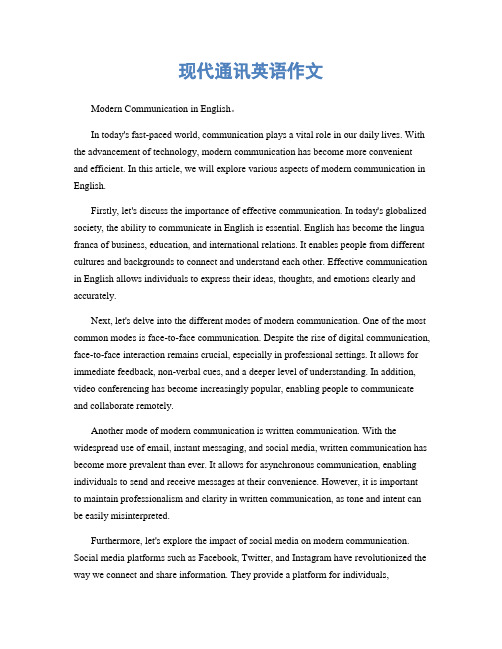
现代通讯英语作文Modern Communication in English。
In today's fast-paced world, communication plays a vital role in our daily lives. With the advancement of technology, modern communication has become more convenient and efficient. In this article, we will explore various aspects of modern communication in English.Firstly, let's discuss the importance of effective communication. In today's globalized society, the ability to communicate in English is essential. English has become the lingua franca of business, education, and international relations. It enables people from different cultures and backgrounds to connect and understand each other. Effective communication in English allows individuals to express their ideas, thoughts, and emotions clearly and accurately.Next, let's delve into the different modes of modern communication. One of the most common modes is face-to-face communication. Despite the rise of digital communication, face-to-face interaction remains crucial, especially in professional settings. It allows for immediate feedback, non-verbal cues, and a deeper level of understanding. In addition, video conferencing has become increasingly popular, enabling people to communicate and collaborate remotely.Another mode of modern communication is written communication. With the widespread use of email, instant messaging, and social media, written communication has become more prevalent than ever. It allows for asynchronous communication, enabling individuals to send and receive messages at their convenience. However, it is importantto maintain professionalism and clarity in written communication, as tone and intent can be easily misinterpreted.Furthermore, let's explore the impact of social media on modern communication. Social media platforms such as Facebook, Twitter, and Instagram have revolutionized the way we connect and share information. They provide a platform for individuals,businesses, and organizations to communicate and engage with a global audience. However, it is crucial to be mindful of the potential drawbacks of social media, such as the spread of misinformation and invasion of privacy.In addition to social media, mobile communication has also significantly transformed modern communication. With the widespread use of smartphones, individuals can communicate anytime and anywhere. Mobile communication enables us to make phone calls, send text messages, and access the internet on the go. It has made communication more convenient, but it is important to strike a balance and not let it consume our lives.Lastly, let's touch upon the importance of effective listening in modern communication. Communication is a two-way process, and listening plays a crucial role in understanding and responding appropriately. Active listening involves giving our full attention, asking clarifying questions, and providing feedback. It fosters better relationships, prevents misunderstandings, and promotes effective communication.In conclusion, modern communication in English has become an integral part of our lives. It allows us to connect with others, share information, and collaborate on a global scale. Whether it is face-to-face communication, written communication, social media, or mobile communication, it is important to communicate effectively and listen attentively. By harnessing the power of modern communication, we can navigate the complexities of the modern world and foster meaningful connections.。
我们应该有全球通信的英语作文
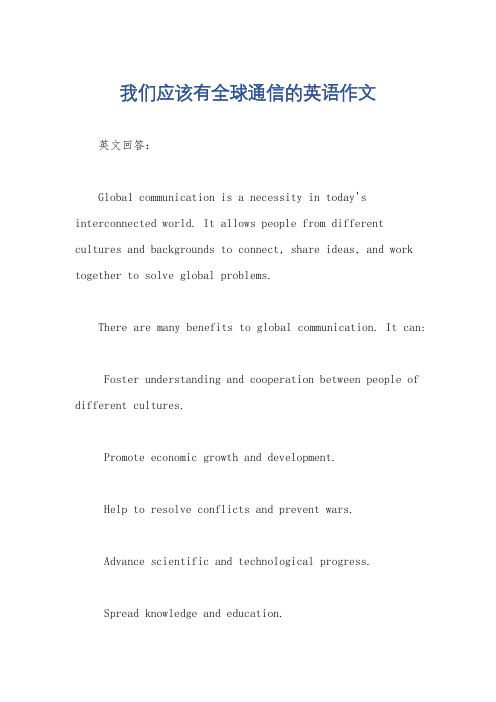
我们应该有全球通信的英语作文英文回答:Global communication is a necessity in today's interconnected world. It allows people from different cultures and backgrounds to connect, share ideas, and work together to solve global problems.There are many benefits to global communication. It can:Foster understanding and cooperation between people of different cultures.Promote economic growth and development.Help to resolve conflicts and prevent wars.Advance scientific and technological progress.Spread knowledge and education.Global communication has also become increasingly important in the context of globalization. As the world becomes more interconnected, it is essential to have effective communication channels to facilitate trade, investment, and cultural exchange.There are a number of different ways to facilitate global communication. These include:The internet.Social media.Telecommunications.Transportation.The internet has been a major driver of global communication in recent years. It has made it possible for people from all over the world to connect with each other instantly and share information. Social media platformssuch as Facebook, Twitter, and Instagram have also played a significant role in connecting people and facilitating communication.Telecommunications networks have also been essentialfor global communication. They allow people to make phone calls, send emails, and text messages to people anywhere in the world. Transportation networks have also made it easier for people to travel and meet each other face-to-face.Global communication is a powerful tool that can be used to improve the world. It can help to foster understanding, cooperation, and peace. It can also promote economic growth, development, and progress.中文回答:我们应该有全球通信。
移动通信英文作文
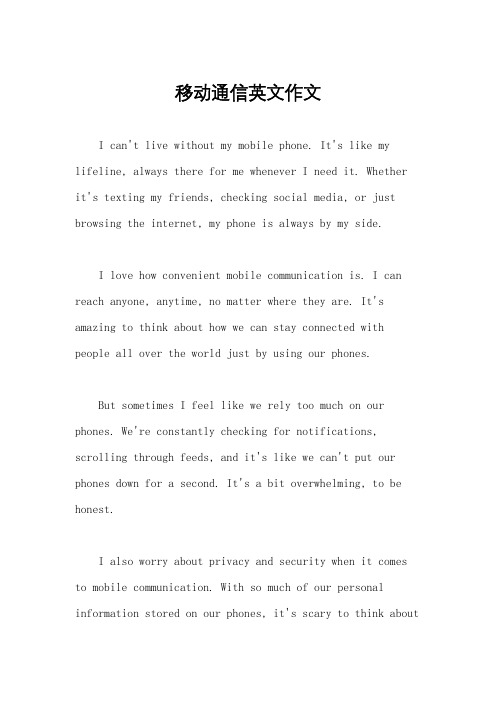
移动通信英文作文I can't live without my mobile phone. It's like my lifeline, always there for me whenever I need it. Whether it's texting my friends, checking social media, or just browsing the internet, my phone is always by my side.I love how convenient mobile communication is. I can reach anyone, anytime, no matter where they are. It's amazing to think about how we can stay connected with people all over the world just by using our phones.But sometimes I feel like we rely too much on our phones. We're constantly checking for notifications, scrolling through feeds, and it's like we can't put our phones down for a second. It's a bit overwhelming, to be honest.I also worry about privacy and security when it comes to mobile communication. With so much of our personal information stored on our phones, it's scary to think aboutwhat could happen if someone were to hack into it.On the other hand, mobile communication has made so many things easier. I can do my banking, order food, and even book a ride with just a few taps on my phone. It's like having a personal assistant right in my pocket.Overall, I think mobile communication has its pros and cons. It's incredibly convenient, but it's also important to find a balance and not let it take over our lives.。
Mobile and Wireless Communications
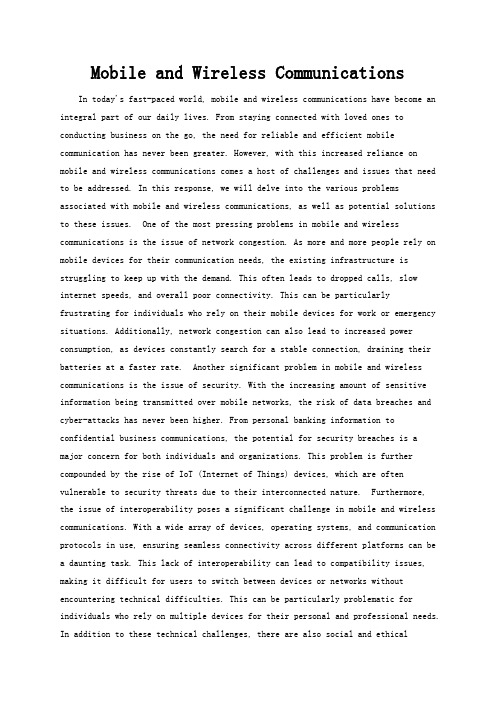
Mobile and Wireless Communications In today's fast-paced world, mobile and wireless communications have become an integral part of our daily lives. From staying connected with loved ones to conducting business on the go, the need for reliable and efficient mobile communication has never been greater. However, with this increased reliance on mobile and wireless communications comes a host of challenges and issues that need to be addressed. In this response, we will delve into the various problems associated with mobile and wireless communications, as well as potential solutions to these issues. One of the most pressing problems in mobile and wireless communications is the issue of network congestion. As more and more people rely on mobile devices for their communication needs, the existing infrastructure is struggling to keep up with the demand. This often leads to dropped calls, slow internet speeds, and overall poor connectivity. This can be particularlyfrustrating for individuals who rely on their mobile devices for work or emergency situations. Additionally, network congestion can also lead to increased power consumption, as devices constantly search for a stable connection, draining their batteries at a faster rate. Another significant problem in mobile and wireless communications is the issue of security. With the increasing amount of sensitive information being transmitted over mobile networks, the risk of data breaches and cyber-attacks has never been higher. From personal banking information to confidential business communications, the potential for security breaches is amajor concern for both individuals and organizations. This problem is further compounded by the rise of IoT (Internet of Things) devices, which are often vulnerable to security threats due to their interconnected nature. Furthermore,the issue of interoperability poses a significant challenge in mobile and wireless communications. With a wide array of devices, operating systems, and communication protocols in use, ensuring seamless connectivity across different platforms can bea daunting task. This lack of interoperability can lead to compatibility issues, making it difficult for users to switch between devices or networks without encountering technical difficulties. This can be particularly problematic for individuals who rely on multiple devices for their personal and professional needs. In addition to these technical challenges, there are also social and ethicalissues that need to be considered in the realm of mobile and wireless communications. For example, the issue of digital divide remains a significant problem, with many individuals and communities lacking access to reliable mobile connectivity due to economic or geographical reasons. This not only hinders their ability to stay connected with the rest of the world but also limits their access to essential services and resources. Furthermore, the pervasive use of mobile devices has raised concerns about the potential health effects of prolonged exposure to wireless radiation. While the scientific community remains divided on the long-term health implications of wireless communication technologies, the public perception of potential health risks can have a significant impact on the adoption and usage of mobile devices. To address these problems, a multi-faceted approach is necessary. From a technical standpoint, investments in infrastructure and technology upgrades are crucial to alleviate issues such as network congestion and interoperability. This could involve the deployment of 5G networks, which promise faster speeds and lower latency, as well as the development of standardized communication protocols to ensure seamless connectivity across different devices and platforms. In terms of security, robust encryption and authentication mechanisms need to be implemented to safeguard sensitive data transmitted over mobile networks. Additionally, user education and awareness programs can help individuals and organizations better understand the potential security risks and how to mitigate them through best practices and security measures. From a social and ethical perspective, efforts to bridge the digital divide through initiatives such as subsidized connectivity programs and infrastructure development in underserved areas are essential. This will not only help improve access to mobile communication for all but also contribute to overall societal development and inclusivity. In conclusion, while mobile and wireless communications have revolutionized the way we connect and communicate, there are several challenges that need to be addressed to ensure a seamless and secure experience for users. By taking a holistic approach that encompasses technical, social, and ethical considerations, we can work towards creating a mobile communication environment that is reliable, accessible, and safe for all.。
- 1、下载文档前请自行甄别文档内容的完整性,平台不提供额外的编辑、内容补充、找答案等附加服务。
- 2、"仅部分预览"的文档,不可在线预览部分如存在完整性等问题,可反馈申请退款(可完整预览的文档不适用该条件!)。
- 3、如文档侵犯您的权益,请联系客服反馈,我们会尽快为您处理(人工客服工作时间:9:00-18:30)。
/New Media & Society/content/13/3/363The online version of this article can be found at: DOI: 10.1177/1461444810393899 2011 13: 363 originally published online 31 March 2011New Media Society Rich Ling and Heather A. Horst Mobile communication in the global south Published by: can be found at:New Media & Society Additional services and information for/cgi/alerts Email Alerts:/subscriptions Subscriptions: /journalsReprints.nav Reprints:/journalsPermissions.nav Permissions: /content/13/3/363.refs.html Citations:What is This? - Mar 31, 2011Proof - May 25, 2011Version of Record >>Corresponding author:Rich Ling, IT University of Copenhagen, Rued Langgaards Vej 7, 2300 Copenhagen S., Denmark. Email: rili@itu.dkIntroductionnew media & society 13(3) 363–374© The Author(s) 2011Reprints and permission: /journalsPermissions.nav DOI: 10.1177/1461444810393899 Mobile communication in the global southRich Ling IT University of Copenhagen, DenmarkHeather A. Horst University of California Humanities Research Institute, USAAbstractMobile communication has become a common phenomenon in most parts of the world. There are indeed more mobile subscriptions than there are people who use the internet. For many people outside of the metropolitan areas of Europe and North America, this is literally their first use of electronically mediated interaction. This preface to the special issue of New Media & Society examines mobile communication in a global context. Through an overview of eight articles situated in the global south, we describe how mobile communication sheds light upon notions of information, appropriation and development and how it is challenging, and in many cases changing, notions of gender. While the mobile phone reshapes development and micro dynamics of gendered interactions, it is not necessarily a revolutionary tool. Existing power structures may be rearranged, but they are nonetheless quite stable. The analysis of mobile communication in the global south helps us to understand the rise of innovative practices around information and communication technologies and, in turn, enables us to develop theory to understand these emergent empirical realities.Keywordsdevelopment, gender, global south, mobile communication, social changeIntroductionMobile phones are thoroughly entrenched in the daily affairs of people throughout the world. On a global basis there are 68 mobile phone subscriptions and 27 internet users364 new media & society 13(3) per 100 people (International Telecommunication Union, 2010). The number of landline telephones is falling. Uptake of the mobile phone in the global south signals an important landmark for the ways that people communicate (Castells et al., 2006). Indeed, the latest statistics show that there are now more mobile phones in the develop-ing world than in the developed world. A ccording to the International Telecommunication Union (2010), four countries represented in this collection of articles, namely China, India, Brazil and Indonesia, have approximately one third of the 4.6 billion mobile phone subscriptions worldwide. For the vast majority of people in the global north, the mobile phone emerged as an extension of the preexisting landline network. However, people living in other parts of the world had only minimal access to telecommunica-tions until the arrival of the mobile phone (Maitland, 1984). Thus, while the internet has seemingly stolen all the headlines, the mobile phone has quietly provided people at the bottom of the income pyramid access to electronically mediated communication; often for the first time.Landline telephony in rural America in the 1920s and 1930s marked a new way of organizing daily life and social interaction (Fischer, 1992). The mobile phone offers the same transition in the global south. It behooves us to pay notice; this is the one chance we will have to understand the dynamics of adoption and appropriation and the conse-quences of these practices locally and globally. In particular, as the articles included in this issue illustrate, the mobile phone affects life at the macro and micro level. From negotiations of gender in public and private to the trajectories of development that are realized in the everyday struggles to communicate, there is no question but that the device has changed daily life for billions of people in the global south.This special issue of New Media & Society focuses upon the implications of these transformations for empirical and theoretical work on mobile communication practices. What are the specific social consequences of these transformations? Has access, adop-tion or appropriation of the mobile phone realized the possibilities of ‘development’ that governments, non-governmental organizations and, increasingly, corporations aspired to create? Has access to communication liberated women? Has the mobile helped to expand social, financial and political networks or does its value lie in its capacity to develop social cohesion? Are these patterns particular to the global south or do they speak to broader patterns of use? Recognizing the growing academic interest in this area, the special issue began in March 2009 with a call for paper proposals. Of the 66 proposals received, we commissioned 25 papers. In addition, we held a pre-conference workshop at the Association of Internet Researchers meetings in Milwaukee, Wisconsin, in October 2009 that focused upon understanding mobile communication practices outside of Northern Europe, North America and East Asia. After external peer reviews, eight papers were selected for inclusion out of this much larger field of academic work.In setting out the call for proposals, we felt strongly that the special issue should focus upon the everyday social and cultural dimensions of mobile communication rather than innovative platforms, development programs or policies. We also attempted to include a diverse set of geographic regions, including rural and urban areas across Latin America, Africa and Asia-Pacific. While not entirely representative, articles range from urban China (Wallis), rural Indonesia (Chib and Chen), Filipino migrants (Madianou and Miller), urban Brazil (de Souza e Silva et al.), urban Senegal (Lexander),Ling and Horst 365 urban Mozambique (Archimbault), rural and urban Ghana (Sey) and the Kerala region of southern India (Palackal et al.). In the following section, we turn to two, broad contributions to the mobile communication literature that emerged in this set of articles. The first set of articles focuses upon mobile communication and development in the global south, with particular attention to the meaning of development in light of broader usage trends. The second set of articles dives more deeply into issues of gender dynam-ics in particular socio-cultural contexts.Mobile communication in the global south: key contributions As noted previously, examining the adoption and use of mobile telephony in the global south provides us with an opportunity to see how this new communication technology intersects with, changes and makes more visible existing social relations. Its adoption challenges pre-existing structures in society and pre-existing notions of how interac-tion should take place. Collectively, the articles contribute to our understanding of social, cultural, gendered and political relations on a global and local scale. This, in turn, provides insight into the determinants, obstacles and implications of mobile communication.Development,appropriation and social changeGiven the locations of the research represented in this volume, the issue of social and economic development crosscuts all of the articles. Like computers and the internet, mobile phones have captured the attention of a range of stakeholders in international development agencies, government entities, corporations and most importantly among common people. Mobile phones’ relative accessibility, affordability and ease of use (compared to the PC) hold the promise of bridging the so-called digital divide. New programs such as M-Pesa in Kenya, the m-health initiatives of different agencies and a wide range of mobile information diffusion projects have all illustrated the potential of mobile phones to be utilized as instruments of development. While many of these efforts have yielded important successes organizationally, financially and personally for those who live outside of the industrialized centers of the north, the articles in this issue col-lectively reveal how everyday uses and effects challenge monolithic visions of the ‘effects’ of mobile phones and mobile phone interventions.Araba Sey’s article on mobile phones in Ghana addresses the tension between ICTs for development (ICT4D) and ICTs and development most directly. Defining human welfare broadly to encompass utilitarian and seemingly non-utilitarian uses of mobile phones, Sey begins by mapping the motivations to purchase, use and perceived benefits of the mobile. She reveals the myriad motivations and practices that underline appropria-tion in Ghana. Importantly, and as we see outside of the global south, Sey refuses to reduce usage to either economic or social uses and, in turn, privilege one sort of use over another. One point in her analysis is that the motivation to have a mobile phone is not the result of a centrally planned development initiative, but it is simply individuals adopting technology that makes sense to them and helps them with the arrangement of their daily affairs. This is a theme that arises in many of the articles.366 new media & society 13(3) This same motivation can be seen in the work of Palackal et al., whose article examines how the mobile phone changed the way that friendship and familial interaction took place in Kerala in the period between 2002 and 2007. Using repeated measures in a cross-sectional design, they find that the mobile phone has resulted in the tightening of social cohesion among the closest friends and family. There is a corresponding decrease in the social links for those outside of these groups. They find that mobile communica-tion supports interaction with core members of the social sphere while it also distances people who are outside this sphere. These findings correspond to others in Japan, Taiwan, the US and Europe (Ito and Okabe, 2005; Ling, 2004) and suggest that mobile telephony does not expand social sphere but rather intensifies our social networks. This is a some-what different dynamic than is common in the PC-based internet. This distinction tells us two things. First, the fact that this pattern is observed in India suggests that this is not merely a function of income or position in the global north or south. Secondly, and as Sey also highlights, social networks are varied in purpose and use. Rather than establishing a dichotomy between either using the mobile phone for social cohesion, or to expand net-works, it is important to understand the motivation behind use in relation to the mobile phone’s affordances.The article by Adriana de Souza e Silva et al. pushes our notions of appropriation and adoption further by focusing upon how Brazilians in Rio de Janeiro incorporate mobile phones into their lives. Comparing the use of mobile phones among three communities of favela (slum) residents in Rio, the authors explore how appropriation, particularly the tension between legal and illegal access, are negotiated through the acquisition and con-tinued use of mobile phones. Comparing practices such as sharing, directao and cloning, the authors engage with Bar, Pisani and Weber’s (2007) notion of appropriation in the Brazilian context. Importantly, de Souza e Silva et al. also reveal that appropriation among low-income residents is not separate from high-income residents, but remains intricately connected through the power dynamics and geographical realities that tie them together in other aspects of life. The authors also conclude that focusing upon dichotomies of ‘have’ and ‘have-not’ notions of access fails to capture the diverse ways in which people develop relationships with technologies like mobile phones.Lexander’s detailed study in Dakar, Senegal reveals that it is not only access to phones but the modality of communication that is often fraught. Specifically, she examines the use of texting in Senegal where the official language is French but where the predominant language is Wolof and there is common use of a third language Fulfude. In addition, English, Spanish and Arabic are a part of the mix. Given the quasi-oral nature of texting (Baron, 1998; Baron and Ling, 2003), texting emerges as a potential outlet for more authentic forms of expression and participation in the language of everyday speech (Street, 2001). Exploring code switching and the micro-dynamics of these interactions becomes a way to understand the transition in language practices. It also becomes a way to under-stand the interaction between the official language policies and the way that a language commonly associated with illiteracy is used in daily interaction. Lexander describes the workings of power and regulation in the face of more parochial identity construction.Whereas de Souza e Silva et al. and Lexander stress the macro power dynamics at play through everyday forms of negotiation and resistance over the access to and modalities of communication, Archimbault’s analysis of urban Mozambique brings up an importantLing and Horst 367 dimension of mobile communication, namely the abridged ability to control the message in romantic relations. There is often a line of thought suggesting that adoption of new technologies will only have positive effects. The mobile phone is no exception. There are many articles describing how it facilitated commerce (Jagun et al., 2008; Jensen, 2007), allows better coordination (Donner, 2007) and generally makes life easier. This line of narration often does not take into account the difficulty of parsing information and the inadvertent spreading of disruptive information. The area of interpersonal relations is particularly open to this. In the work by Archimbault the reader finds that the ease of com-munication can actually backfire and cause misunderstandings. The same phenomenon has been observed in industrialized countries. Teens in Scandinavia, for example, have to learn how to arrange smaller parties discreetly since the word that a party is to be found at a particular address can spread virally (Ling and Donner, 2009). In Jamaica, Horst and Miller (2006) found that men and, to a lesser degree, women made efforts to disguise the names and numbers saved in their phone and tend to avoid using voicemail and other forms of communication (e.g. SMS) that leave behind a trail. Lásen has also described the lengths to which romantic partners need to go when they are continually available to one another via the mobile phone (Làsen, 2011). Thus, mobile phones bring new problems and dilemmas for those who wish to share, spread or hide information.So much of the literature on mobile phones, development and social change hinges upon a belief that information circulation is critical to development and the building of healthy communities. Yet, as we see here, it’s important to remember that informa-tion, the processes of spreading information and even the language of communication itself are not value neutral. As Sey illustrates, people’s reasons for appropriation of mobile phones are varied and change over time depending upon interest, income and other factors. These motivations and aspirations clearly shape the development poten-tial of mobile phones. Palackal et al. make the case that mobile phones are facilitating local family and friendship networks, which corresponds with broader trends docu-mented by Ling (2008) and others. Yet, research also shows that extended networks have also been enhanced though use of mobile telephony (Horst and Miller, 2005; Tenhunen, 2008; see also Sey in this issue). In this issue, we also see that in the work-place, such as with the migrant women in Wallis’s study, the midwives in Chib and Chen’s study, and the users in urban and rural Ghana as investigated by Sey, the capac-ity to reach out to broader networks in the cultivation of expertise, support and oppor-tunity is equally valuable even if these practices do not receive the same air time or energy as the cultivation of close, personal networks. These practices may result in more secure employment or increase in income but, much as in the global north, are not often the primary reason that these networks are cultivated. Both can be construed as amenable to development. In the work by de Souza e Silva et al. we see how con-temporary efforts to acquire mobiles draw upon long-standing historical practices of using utilities from the wealthy community neighbors living nearby, and Lexander reminds us to pay close attention not only to what is being communicated and circu-lated, but also how – and in what languages – these conversations take place. It is clear that when contemplating development, futures and other social change, we need to unpack our assumptions about concepts like ‘information’, ‘appropriation’, ‘cohesion’ and attendant values.368 new media & society 13(3) GenderSeveral of the articles look at different dimensions of gender vis-à-vis the mobile phone. Harking back to the idea of the mobile as a Garfinklian breaching experiment, gendered use of the mobile phone can set women’s situation into visible relief. As noted by Fischer when describing the introduction of the landline telephone in the US, the enhanced abil-ity to coordinate and to engage in social interaction changes the horizon for women (Fischer, 1992). It also provides them with a radius of action that may disrupt pre-existing ideas of their appropriate role. Looking at the context of the global south Jagun, Heeks and Whalley (2008) also observe that mobile telephony places women in a broader flow of events and gives them the ability to enlarge their sphere of interaction (Jagun et al., 2008). It is not clear whether this will translate into a dramatic power shift, but it definitely changes the dimensions of the interaction.In some of the articles we find that it is seen as legitimate and even necessary for the women to have a mobile phone. Madianou and Miller examine how the mobile phone becomes a tool maintaining contact between Filipina mothers who live and work in the UK as maids while their children remain behind in the Philippines. While they were able to maintain contact, the solution was not a panacea. The device allowed mothers to cul-tivate the sense that they were an active part of their children’s lives. It also allowed them help legitimate of their working overseas. The perspective of their children was some-what different. While they valued the calls from their mothers, they also expressed ambivalence to the idea that their mothers were an integral part of their lives. This became obvious when their mothers returned for visits to the Philippines and tried to reassert their role as co-located parents. The children reacted to their mother’s temporary reassertion of authority in light of the norm of distance. The mobile phone kept the con-nection between the mother and child open, but it was not a substitute for the full range of interpersonal interactions.There is also a tension in the use of the mobile phone by young rural-to-urban migrant women in China as described by Wallis. The mobile phone gives women some advantages in terms of finding jobs and maintaining contact with peers. Yet, it is also a channel through which employers can surveil and harass the women in her study, practices that reinforce patriarchal power relationships. Indeed, in order to ingratiate themselves with employers, Wallis describes situations where employers (who can also be relatives) expect women to use their personal phones to generate additional income. While there is often a liberation rhetoric associated with mobile telephony (Law and Peng, 2006; Rafael, 2003; Rheingold, 2002), the analysis by Wallis shows that the technology can cut two ways. It can provide users with new functionality and a way to maintain their social sphere. At the same time, it can be used to control users and encourage them to do the bidding of others. This is not to say that the women reject using mobile phones. Indeed mobile phones are sought after, the devices give the women access to relatives ‘back home’ and they are seen as important possessions. Wallis shows how the mobile phone can benefit young women in terms of access to jobs and other resources, but also provides opportunities for women to be taken advantage of or controlled by their employers and others.In the previous articles, women’s access to and use of mobile phones was relatively uncontroversial. The situation is not as clear for the female midwives studied by ChibLing and Horst 369 and Chen where women can experience a status where their status as ‘women’ presents a conflict in their worklifes in the Aceh province in Indonesia and use a mobile phone to support their work. The mobile phone is an obvious link to technically developed society that is juxtaposed with a system where women do not have high status. Chib and Chen’s analysis shows that the midwives (all of whom were women) value having mobile phone since it gives them access to important medical information and it allows them to mobi-lize more quickly in emergency situations. It also gives them autonomy in their work and a certain status in the eyes of the broader community. At the same time their material shows that some people felt that the mobile phone gave the women claim to a status that is not recognized in other dimensions of their lives. This violates their own and other’s sense of their position. The introduction of the mobile phone illuminates this disjunction in the status of the women. Because of this the midwives were sometimes leery of using it to assert status.The four articles that take up the issue of gendered use (Madianou and Miller; Wallis; Chib and Chen; and finally Archimbault discussed in the previous section) illustrate three broad points. First, there exists question throughout many parts of the world as to whether women should own or use mobile phones. Somewhat parallel to the discussions as to whether children should have a mobile phone, the work of Chib and Chen reveals that issues of morality remain key to understanding use in many places. Second, several of these articles tell us that mastering of discourse via the mobile phone is not taken for granted and ‘information’ that circulates is open to interpretation based upon gender dynamics and social context (Archimbault). Finally, there is disagreement with regards to the proper sphere of use (Madianou and Miller, Wallis). While women actively used the phone, there was not necessarily agreement as to what constituted correct use. The children of Filipino maids did not necessarily respect the intrusion of their mothers into their lives and the young Chinese women described by Wallis did not agree with their employers as to the correct use of the device.As with the articles describing the mobile phone in the errand of development, there is generally a consensus that the device is positive. The questions over ownership, use and empowerment arise, however, when considering specific uses and when the technol-ogy is mapped onto pre-existing gender dynamics that often favor men as opposed to women. In order to manage this tension the women use different strategies and cultivate peer support. As the articles reveal, the negotiation of this can create problems and dilem-mas that challenge accepted norms and behavior.Where we are and where we’re going: implications for theory The adoption and use of the mobile phone in the global south has been enthusiastic. The statistics of adoption give us a sense of the device’s popularity. Several of the articles, however, reveal the reasons behind this wide-scale acceptance in spite of the fact that the device costs money and that it does not necessarily overturn existing power dynam-ics. Those who have more powerful positions in society still have control of many resources, i.e. money, jobs, status, notions of appropriate roles, etc. However, the ability of the relatively powerless people to communicate in spite of their position means that the dynamics of the situation have been changed. The women in Wallis’ work describe370 new media & society 13(3) the lengths that they are willing to go to acquire a mobile phone and the same can be seen in the work by Sey. It is perhaps most striking in the work of de Souza e Silva et al.’s examination of mobile phone use among the poor in Rio where the authors find that favela residents actively worked at bending the rules to obtain access to mobile phones and other services by whatever means necessary. We see the same issue in the innovative approaches to use described by others. The work on missed calls (Donner, 2007; Geirbo et al., 2007), the various forms of trafficking in used phones of various caliber (Mathews, 2009; Wallis et al., 2009) and scrape card subscriptions show the dynamics when there is a mismatch between the interest in using a mobile telephony and commanding the resources for this use. Sey and Palackal et al. show us that there are social benefits for the individual associated with this development. The work by Madianou and Miller and that of Wallis indicate that in many cases there is almost a ‘taken for granted’ nature to mobile phone ownership.Once adopted the device has a hand in shaping everyday routines. The material here does not depict revolutionary changes in daily life, but rather it describes existing activities that have been adjusted and re-shaped by access to mobile communication. We also see that users must learn to calibrate their use of the device and the gap between the intentions of the person sending the message and the interpretation of the message’s receiver. The articles by Archimbault, Madianou and Miller and Wallis reveal how there can be misunderstandings and problems when new forms of mediation replace more traditional ones. We see that mobile communication has the potential to facilitate coordination (Sey; de Sousa e Silva et al.) and social cohesion (Palackal et al.; see also Ling, 2008). The mobile phone also shapes and, in some instances, shakes up the way that we interact, spurring the need to readjust pre-existing social relationships. Seen through the lens of power, the mobile phone changes the rules regarding who can inter-act with whom. Those who earlier controlled the means of communication find that there is a new, alternative channel for interaction. This is not necessarily to say that the mobile phone is a revolutionary tool. While there are examples of the mobile phone being used to organize broader, more formal social protests, the types of interactions described in this issue are more at a mundane daily level. In particular, women find that the device gives them access to others who were difficult, or impossible to contact before. They can go outside the traditional communication channels and come in direct contact with their interlocutors. Criminals can adopt the technology for their ends (de Sousa e Silva et al.), individuals can misconstrue the intentions of their interlocutors (Archimbault) and by making oral traditions textual, disjunctions in the linguistic proj-ect of nation building come to light when local languages gain a new identity (Lexander).This theme echoes the analysis of mobile telephony that examines how perpetual contact, to use the apt phrase of Katz and Aakhus (2002), plays into social interaction. A long series of authors have studied how mobile telephony allows for constant contact (Licoppe, 2004), individual addressability (Ling and Donner, 2009) and micro-coordination (Ling and Yttri, 2002). As with the behaviors described in these studies, mobile tele-phony became a significant element in social interaction, playing an important role in the reshaping rather than replacement of previous forms of communication. This theme is reflected in many of the articles in this issue.。
